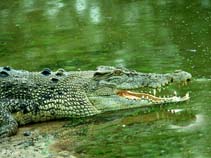Advertisement
Crocodylus porosus Schneider, 1801
Estuarine crocodile| Native range | All suitable habitat | Point map | Year 2050 |

|
| This map was computer-generated and has not yet been reviewed. |
| Crocodylus porosus AquaMaps Data sources: GBIF OBIS |
Singapore country information
Common names:
[No common name]
Occurrence: introduced
Salinity: marine
Abundance: | Ref:
Importance: | Ref:
Aquaculture: never/rarely | Ref:
Regulations: no regulations | Ref:
Uses: no uses
Comments: National Red List Status: Critically Endangered. Threats to this animal include habitat destruction and over-hunting for its hide and meat (Ref. 85385). C: Refs. 85385, 356; O: Ref. 85385.
National Checklist:
Country Information: https://www.cia.gov/library/publications/resources/the-world-factbook/geos/sn.html
National Fisheries Authority:
Occurrences: Occurrences Point map
Main Ref: Lim, K.K.P., N. Baker, R. Teo and L.T. Ming, 2008
National Database:
Occurrence: introduced
Salinity: marine
Abundance: | Ref:
Importance: | Ref:
Aquaculture: never/rarely | Ref:
Regulations: no regulations | Ref:
Uses: no uses
Comments: National Red List Status: Critically Endangered. Threats to this animal include habitat destruction and over-hunting for its hide and meat (Ref. 85385). C: Refs. 85385, 356; O: Ref. 85385.
National Checklist:
Country Information: https://www.cia.gov/library/publications/resources/the-world-factbook/geos/sn.html
National Fisheries Authority:
Occurrences: Occurrences Point map
Main Ref: Lim, K.K.P., N. Baker, R. Teo and L.T. Ming, 2008
National Database:
Common names from other countries
Classification / Names Κοινά ονόματα | Συνώνυμα | Catalog of Fishes (gen., sp.) | ITIS | CoL | WoRMS
Environment: milieu / climate zone / depth range / distribution range Οικολογία
Πελαγικό(ά); ωκεανόδρομο(ς) (Αναφ. 77091); Γλυκού νερού; εύρος βάθους 0 - 200 m. Tropical; 41°N - 36°S, 77°E - 171°E (Αναφ. 356)
Distribution Χώρες | Περιοχές FAO | Οικοσυστήματα | Παρουσίες | Εισαγωγές
Indo-West Pacific.
Length at first maturity / Μέγεθος / Weight / Age
Maturity: Lm 110.0 range ? - ? cm Max length : 615 cm TL αρσενικό/απροσδιόριστο; (Αναφ. 77094)
Short description Μορφολογία
Large head and strong snout with a pair of ridges bridging the orbits. Uniform dorsal scales. Very variable coloration. Juveniles with black bands and spots. Body with 4-5 black bands which may disappear in very large individuals. The belly is uniformly colored beige to golden yellow. Some individuals maybe highly pigmented.
May cross open ocean as evidenced by occurrence in remote islands in the Indian Ocean and in the western Pacific Ocean (salinity range 5-20 per mille). Inhabits a wide range of habitats (rivers, creeks, swamps, lagoons and billabongs); needs a source of water less salty than their blood (blood plasma salinity of 11per mille). Ref. 77096 reports a maximum length of 700 cm total length and a maximum weight of 1000 kg for captive individuals. Often basks on open mud banks in cooler months and often in the shade of mangrove areas in warmer months. Has a strong homing ability. Oceanodromous individuals may have barnacles attached to their scales (Ref. 77096). May also have endoparasites, i.e., round worms, tongue worms and flukes (Ref. 77091). Crocodile eggs and flesh are food for humans, while crocodile skin (notably near the belly) are used by the leather industry mostly from farmed crocodiles (Ref. 77091). Known to attack humans, sometimes fatally (Ref. 077096, 077099). Active throughout the year. Hunts by day and night; hunting probably associated to diving behavior. Size determines feeding, i.e., small crocodiles feed frequently on small prey items while larger crocodiles feed infrequently on larger prey. May consume carrion. Gastroliths (stomach stones) help in digesting food items (Ref. 77091).
Main reference
Αναφορές | Συντονιστής | Συνεργάτες
Greer, A.E. 2006. (Αναφ. 77091)
IUCN Red List Status
(Αναφ. 130435: Version 2024-2)
Least Concern (LC) ; Date assessed: 14 November 2019
CITES status (Αναφ. 108899)
Appendix I: International trade banned
CMS (Αναφ. 116361)
Appendix II: Migratory species conserved through agreements
Threat to humans
Traumatogenic (Αναφ. 77096)
Human uses
αλιεία: Εμπορικό(ά); Υδατοκαλλιέργειες: Εμπορικό(ά)
FAO - αλιεία: landings | FishSource | Η θάλασσα γύρω μας
Εργαλεία
Περισσότερες πληροφορίες
Διαδικτυακές πηγές
BHL | BOLD Systems | CISTI | DiscoverLife | FAO(αλιεία: ; publication : search) | GenBank (genome, nucleotide) | GloBI | Gomexsi | Google Books | Google Scholar | Google | PubMed | Δέντρο Ζωής | Wikipedia (Go, αναζήτηση) | Zoological Record
Estimates based on models
Preferred temperature
(Ref. 115969): 24.2 - 29.1, mean 28.1 (based on 3318 cells).
Ελαστικότητα
(Αναφ. 69278)
Υψηλό, ελάχιστος χρόνος για διπλασιασμό πληθυσμού < 15 μήνες (K=0.71-2.5).
Price category
(Αναφ. 80766):
Unknown.




